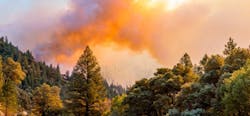Water Quality Standards & Natural Disasters
Frank Brigano, Ph.D., is vice president and senior research fellow for Marmon Water Inc. Brigano can be reached at [email protected]. Andrea Scarpino, Ph.D., is president & CEO for PVS Associates. Scarpino can be reached at [email protected].
undefinedWe live in a fragile environment that is becoming even more fragile with our changing climate. As our climate grows more unpredictable in the coming decades, natural disasters like hurricanes, floods and tornados are expected to increase, further straining our current water infrastructure and adversely affecting our air, water and land quality. Natural disasters can also lead to acute or chronic health problems and result in long-term exposure to potentially harmful substances, whether chemical or microbial. Human-made disasters are typically a result of an accident or failure of safety systems, but our changing climate could complicate those as well.
Wildfires & Water Quality
Take Paradise, California, as a case study. In early November 2018, the Camp Fire, the deadliest fire in California history, decimated Paradise, killing at least 85 people and destroying thousands of homes and businesses. Thought to have been caused by equipment from Pacific Gas & Electric, the fire effected nearly the entire town; Paradise’s population fell after the fire by 90%.
In the months following the fire, another environmental disaster unfolded: the blaze was found to have contaminated the town’s water system with benzene, a known carcinogen, and other volatile organic compounds. According to NPR, Paradise officials are trying to “pinpoint the source of the contamination, whether it’s from burnt plastic pipes and meters or from the toxic waste from burnt structures that was flushed into the town’s water pipes. Much of the town’s housing stock was older and didn’t have back-flow protection.”
Because of the contamination, returning residents have been instructed to only drink bottled water or purchase refillable water tanks. It is not yet known how extensive the contamination is, but remediation could take years and cost hundreds of thousands of dollars. In the meantime, residents are left paying for their own water.
This is just one example of how our access to safe water is threatened by natural and human-made disasters. How we prepare and respond to these events has a direct bearing on the environmental outcome and the effect on human health.
Water Stress on the Rise
The World Resources Institute recently released its Aqueduct Water Risk Atlas, which depicts global areas of high and low water stress around the world. This interactive map helps us see how the many areas of the world face water stress now.
For example, in the U.S., Colorado and New Mexico are both listed as having an “extremely high” water risk; a natural disaster like flooding or drought could cause enough strain on available water resources to devastate human life. The U.S. fairs better than many places around the world, however. Nearly the entire Indian subcontinent falls within the “high” or “extremely high” water risk category.
Just this summer, officials in Chennai, India, announced that after an incredibly dry monsoon season and poor city planning, their four water reservoirs have run dry; the city has effectively run out of water. This means that a city of 10 million people has lost its public water supply. The Chennai water shortage is exacerbated by lack of proper water management: watershed maintenance and management are poor, causing rainwater to flow directly to the sea instead of being retained on the land and replenishing the groundwater supply. Poor human planning made a climate disaster worse.
Preparing Water Systems for Natural Disasters
Given our changing climate and aging infrastructure, what actions can we take to prevent or reduce environmental and health impacts from both human-made and natural disasters? First, we need to prepare. While it is impossible to prevent a natural disaster, especially as our climate changes, it is within our means to be prepared for one.
For example, the implementation of a home or office water treatment system provides an effective barrier from accidental water contamination, say in a case like Paradise. Typically, contamination events are not realized until long after the event has occurred, so point-of-use (POU) and point-of-entry (POE) systems can provide protection during the period of “not knowing”. Most POU/POE water treatment systems can provide a temporary barrier providing limited, if not complete, protection from the contaminant.
The type of contaminant and its concentration in the water environment are critical to the water treatment system performance. Once the contamination event is disclosed, effective treatment technology should be deployed. It is also important to only use products that have been certified to the NSF/ANSI Drinking Water Treatment Unit Standards, including original replacement filters.
We must also become more active stewards of our water environment. One way of becoming a steward is doing what you can as a family, individual or business to protect our watersheds, which are vital to maintaining our water supply, including both surface water and groundwater. This means not filling in wetlands; maintaining wetland vegetation such as trees, grasses and shrubs; and not encroaching on wetlands. Wetland environments are fragile and must be protected to insure their long-term sustainability, quantity and protect the quality of our drinking water.
As our climate changes and natural disasters are expected to increase in frequency and intensity, it is important to do what we can now to mitigate future water insecurity and contamination and thus, loss of human life.
